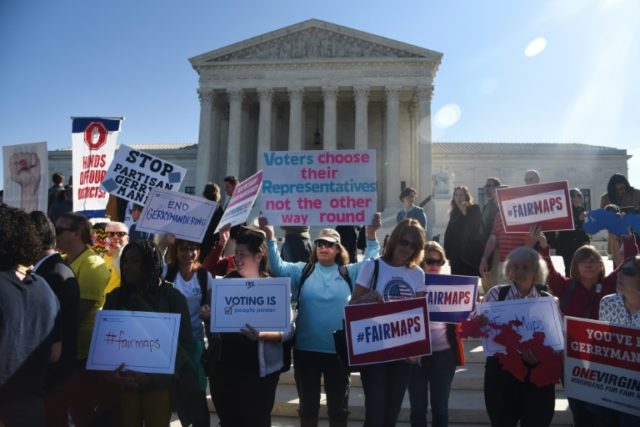Washington (AFP) – The US Supreme Court on Wednesday revisited an issue close to the heart of American democracy: do voters pick their politicians, or is it the other way round, with lawmakers choosing their electorate?
Voters have for decades complained about partisan “gerrymandering” — the widespread practice of redrawing a state’s congressional districts to favor one political party over another.
The much-maligned tactic is a hot topic in the run-up to November’s midterm elections — with Republicans suing over Democrat redistricting in the state of Maryland.
In October, the Supreme Court’s justices heard arguments in a lawsuit on Republican gerrymandering in Wisconsin — but have yet to make a decision on that case.
While the new case accuses the Democrats, most charges of gerrymandering have in the recent past been levied against the Republicans.
The Maryland example is particularly illustrative of the phenomenon: the Democrats previously held six constituencies, the Republicans two.
Then in 2011, the Democrats pushed their advantage by redrawing the electoral map, flipping Maryland’s 6th Congressional District over from Republican to Democrat.
“What the Maryland legislature did was to shuffle 360,000 people out and bring in 350,000 people,” the left-leaning Justice Elena Kagan said Wednesday as the court began hearing the case.
“The result of that is that the district went from 47 percent Republican and 36 percent Democratic to exactly the opposite, 45 percent Democratic and 34 percent Republican.”
“How much more evidence of partisan intent could we need?” she added.
– One person, one vote –
In the US, where Donald Trump was elected with fewer votes than his rival Hillary Clinton, redrawing the boundaries to benefit a particular party is common practice.
For years, the Supreme Court has been reluctant to get involved in gerrymandering cases — unsure of the criteria by which to judge them and fearing a deluge of electoral challenges.
But for the first time, it could set limits on the practice, named after 19th century Republican Elbridge Gerry, who redrew state senate election district boundaries in Massachusetts.
The new boundaries were said to resemble a salamander, giving way to the second part of the term.
“Is there a practical remedy that won’t get judges involved in every — or dozens and dozens and dozens of very important political decisions?” wondered Justice Stephen Breyer, who was appointed by former president Bill Clinton.
“It seems like a pretty clear violation of the Constitution in some form to have deliberate, extreme gerrymandering,” he added.
Under the US Constitution, legislative districts are supposed to be the same size in terms of population, following the legal principle of one person, one vote.
But by redrawing voting blocs along party lines, millions of votes are in effect diluted.
“First Amendment retaliation does not even try to answer the perennial question of how much is too much politics in a redistricting process that this Court has called inherently political,” said Maryland’s solicitor general Steven Sullivan.
The Supreme Court could, by June, set gerrymandering limits by studying the possibility of a technical tool to curb the tactic.
Constituency maps for state and federal elections are usually redesigned following the US Census, carried out once per decade.
In most cases, it is the elected officials of each state who draw up the new districts according to population.
After the 2010 elections, the Republicans controlled Congress and redrew the electoral maps of 21 states.
The Trump administration has decided to add a question on citizenship to the next census, adding a new wrinkle to the issue.

COMMENTS
Please let us know if you're having issues with commenting.